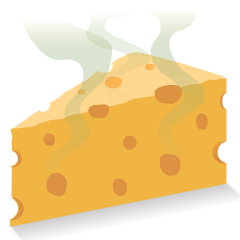🧀Meaning and Description
This is a yellow-orange cheese in the form of triangular wedge, reminiscent of a classic Swiss or Cheddar cheese. Its color, a bright, sunny yellow, brings to mind the creamy richness of dairy, and the holes sporadically scattered on its surface are characteristic of certain types of cheese.
Cheese is a type of dairy product that is made by coagulating milk proteins, usually with the help of bacteria and enzymes. Cheese has a long history that dates back to the Neolithic era, when humans began to domesticate animals and produce milk. According to legend, cheese was accidentally discovered by an Arabian merchant who stored milk🐄 in a pouch made from a sheep's stomach. The rennet in the stomach lining caused the milk to separate into curds and whey, and the curds became cheese. Today, cheese is produced in hundreds of varieties, with different textures, flavors, shapes, and colors.
🧀 can be used to express your love for cheese or your craving for a cheesy dish.
It can also be used to represent money or cash, as "cheddar" is a slang term for money. And it can refer to Wisconsin and its football⚽ team, the Green Bay Packers. Wisconsin is a major cheese producer and Packer fans are affectionately known as "cheeseheads".
Sometimes, 🧀 can indicate posing for a photo, as people often say "cheese" when they are taking photos📸.
Cheese is a type of dairy product that is made by coagulating milk proteins, usually with the help of bacteria and enzymes. Cheese has a long history that dates back to the Neolithic era, when humans began to domesticate animals and produce milk. According to legend, cheese was accidentally discovered by an Arabian merchant who stored milk🐄 in a pouch made from a sheep's stomach. The rennet in the stomach lining caused the milk to separate into curds and whey, and the curds became cheese. Today, cheese is produced in hundreds of varieties, with different textures, flavors, shapes, and colors.
🧀 can be used to express your love for cheese or your craving for a cheesy dish.
It can also be used to represent money or cash, as "cheddar" is a slang term for money. And it can refer to Wisconsin and its football⚽ team, the Green Bay Packers. Wisconsin is a major cheese producer and Packer fans are affectionately known as "cheeseheads".
Sometimes, 🧀 can indicate posing for a photo, as people often say "cheese" when they are taking photos📸.
💡Extended reading and popular science
The meaning of emoji symbol 🧀 is cheese wedge, it is related to cheese, it can be found in emoji category: "🍓 Food & Drink" - "🍕 Prepared Food".
🧀Examples and Usage
🧀Images from Various Manufacturers
🧀Basic Information
| Emoji: | 🧀 |
| Shortname: | cheese wedge |
| Apple Name: | cheese wedge |
| Codepoint: | U+1F9C0 Copy |
| Decimal: | ALT+129472 |
| Unicode Version: | 8.0 (2015-06-09) |
| Emoji Version: | 1.0 (2015-06-09) |
| Categories: | 🍓 Food & Drink |
| Sub Categories: | 🍕 Prepared Food |
| Keywords: | cheese | cheese wedge |
| Proposal: | L2/14‑174 |
👨💻Unicode Information (Advanced Usage)
🧀Trend Chart
🧀Popularity rating over time
Date Range: 2019-04-21 - 2024-04-21
Update Time: 2024-04-22 17:44:25 UTC Emoji 🧀 was released in 2019-07.
Update Time: 2024-04-22 17:44:25 UTC Emoji 🧀 was released in 2019-07.
🧀See also
🧀Relative Topic
🧀Extended Content
🧀More Languages
| Language | Short Name & Link |
|---|---|
| Arabic | 🧀 قطعة جبن |
| Bulgarian | 🧀 резен сирене |
| Chinese, Simplified | 🧀 芝士 |
| Chinese, Traditional | 🧀 起士 |
| Croatian | 🧀 komad sira |
| Czech | 🧀 klínek sýra |
| Danish | 🧀 et stykke ost |
| Dutch | 🧀 stuk kaas |
| Filipino | 🧀 piraso ng keso |
| Finnish | 🧀 juustopala |
Search
Recents
No recent use emoji
Emojify...
Emojify Success



















